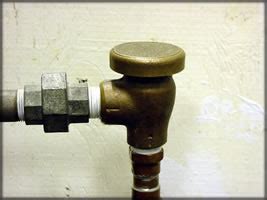A backflow prevention device is a crucial component of any sprinkler system, designed to protect potable water supplies from contamination or pollution. It works by preventing the reverse flow of water from the irrigation system back into the main water supply. This action prevents any water from flowing backward into the municipal water system, safeguarding it from potential pollutants, chemicals, or other contaminants that may be present in the irrigation system.
Typically installed at the point where the irrigation system connects to the main water line, the backflow preventer ensures that water flows in one direction only, effectively preventing any contaminated water from flowing back into the clean water supply.
2 Main Backflow Preventative Devices

Pressure Vacuum Breaker – A Pressure Vacuum Breaker (PVB) is a backflow prevention device commonly used in irrigation systems to protect against contamination of the main water supply. It consists of a brass or plastic assembly that incorporates check valves and an air inlet valve. The PVB is installed above ground and positioned higher than the highest sprinkler head. When water flows through the PVB, the check valves prevent backflow, while the air inlet valve opens to allow air into the system, creating a vacuum that prevents water from flowing backward. The PVB must be properly installed and maintained to ensure the safety of the water supply.

Atmospheric Vacuum Breaker – An Atmospheric Vacuum Breaker (AVB), also known as a Gravity Backflow Preventer, is a simple, compact device used in plumbing and irrigation systems to prevent backflow. It consists of a spring-loaded check valve and an air inlet valve, contained within a single housing. AVBs rely on gravity and atmospheric pressure to create a barrier against backflow. When water flows through the AVB, the check valve opens, allowing water to pass through. If there is a drop in pressure or a reverse flow occurs, the check valve closes, while the air inlet valve opens to break the siphon effect and prevent contamination of the water supply. Gravity Backflows may not provide adequate protection in all situations and may require periodic testing and maintenance to ensure proper functioning.

Direct Connection/No Backflow – A direct connect or no backflow preventer on a sprinkler system refers to a setup where there is no dedicated backflow prevention device installed in the system. In this configuration, the irrigation system is directly connected to the main water supply without any additional safeguards against backflow. While this setup may be simpler and less expensive initially, it poses a significant risk of contaminating the main water supply if backflow occurs. Without a backflow preventer, substances such as fertilizers, pesticides, or other pollutants could potentially flow back into the clean water supply, posing health risks and violating regulatory standards. Therefore, it’s essential to ensure that appropriate backflow prevention measures are in place to protect public health and comply with local plumbing codes and regulations.
Cowboy Lawn and Sprinkler does not service systems with no backflow prevention or a direct connect system. We do require an isolation valve between the backflow prevention device and point we connect our air compressor to blowout a system. This ensures our high volume compressors do not damage parts of your system and ensures the safety of our equipment. Most PVBs have a test cock that diverts air over the top or past the check valve. We do not connect our hoses to points before a backflow prevention device.
